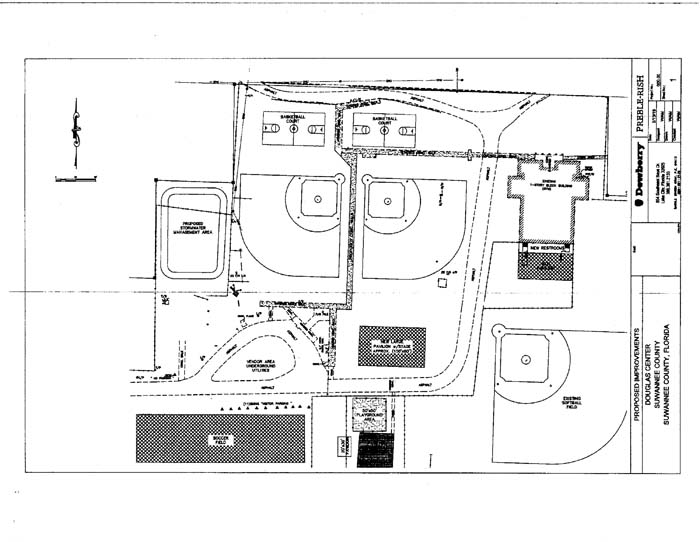BOCC votes to demolish Douglass Center buildings
Published 10:00 am Friday, February 22, 2019

- The proposed plans for the Douglass Center property from the Suwannee Parks and Recreation Department.
LIVE OAK, Fla. — Challenged to make a decision on the future of the Douglass Center at Tuesday night’s board meeting, the Suwannee County Board of County Commissioners did just that.
Following a discussion of more than an hour about the current state of the former school buildings and its future, the board unanimously voted to tear down the current buildings and move forward with plans to let Suwannee Parks and Recreation develop the site with the hopeful addition of a community center at the location.
“Please do something. Somebody have the guts to say what you are or are not going to do so we can get something done for the children that are there before they are senior citizens.”
— Anita Williams, former Douglass student
“I think somebody needs to have the guts to say that the Douglass School is not going to be renovated,” former Douglass student Anita Williams said, adding that once that decision was made, the community could then shift its energy to help shape the future of the property.
“Please do something. Somebody have the guts to say what you are or are not going to do so we can get something done for the children that are there before they are senior citizens.”
The board followed that advice. After a decade of talks and inactivity around devising a plan for the Douglass Center since the Suwannee County School District gave the property to the county in 2008, the buildings have continued to deteriorate.
“I want to see great things for that property,” Commissioner Len Stapleton said.
“But I’ve also sat up here and been chastised and said we’re not making decisions. So right now I’m going to make a motion to remove those buildings and to come back with something beautiful for this community and those kids.”
Stapleton, who had cited the unsafe nature of the buildings, added he hoped the board, the community near the Douglass Center and the Douglass Alumni Association could work together to develop a plan for a community center that could be developed on the site as well. That community center could replicate the existing Douglass school as well as be the site of a Douglass school museum and be available for events.
“I’m willing to listen and do anything we can to come to an agreement where everybody is happy,” he said.
That motion, which was seconded by Chairman Ricky Gamble as he passed the gavel to Vice Chair Don Hale, came after discussion about holding a public meeting to inform the residents near the Douglass Center, which lies in Clyde Fleming’s district. Fleming is also a Douglass alum, who added his vision for the property also includes a multi-purpose building.
Robert Ford, President of the Douglass Alumni and who had his own Douglass Center items on the board’s agenda including the addition of a Legacy Memorial Park at the site which was approved by the board, welcomed that community meeting. Ford said he wanted an open dialogue with all the stakeholders involved in the project.
Commissioner Ronnie Richardson also liked the idea of a community meeting, believing the board should allow the residents to “have a voice.”
Gamble and County Administrator Randy Harris, though, said years of public meetings, Douglass Center boards and workshops have proven fruitless. Gamble did repeatedly say involving the public in the vision moving forward was important, which was an idea Williams had suggested as well.
Ford, though, said he felt like the board was working against salvaging the current buildings, although he admitted earlier in the meeting that some of the buildings needed to be torn down, focusing his efforts on the front wing and the wing that contained the cafeteria and library.
“This assessment that they’re not suitable for occupancy, I’m taken aback by all that,” he said in response to a memo from County Attorney Jimmy Prevatt that instructed the board to not allow the current buildings to be used due to issues with air quality due to the lack of insulation and a vapor barrier as well as roofing leaks and the addition of air conditioning that caused moisture problems. He said the topography of the property also led to water running towards and into the buildings, problems that could not be addressed. The buildings have also been repeatedly vandalized and broken into, furthering the commissioners’ safety concerns.
Ford later added he felt “blindsided” by the discussion to do away with the buildings and utilizing a plan from Parks and Recreation Director Greg Scott that would use the property for the addition of ballfields.
Scott’s vision for the property, he said, was centered around leaving a legacy of what the Douglass Center means for the community as well as providing a safe space for children to use and play.
Scott also welcomed a town hall meeting to find out exactly what kind of facilities and fields the neighborhood would want to see at the site if the board decided to move forward with his plan.
“It’s about pride,” Scott said. “We need to take pride in that space and start making the improvements we need to make.”
Both members of the board and Ford noted the property needs to be available for the families, especially children, in the area. Ford said the inability to host the PAL summer program last year due to Prevatt’s recommendation of no occupancy was a shame.
Gamble agreed that the children in the area were missing out on using the center, but with the board unwilling to invest millions of dollars into cosmetic upgrades that still wouldn’t address air quality and moisture issues at the site, future children would lose out too if progress wasn’t made.
“We’ve been talking about this for 8-9 years,” Gamble said. “That’s almost a generation now that’s been missed.
“How many generations do we miss before we do something that is going to benefit?”
Gamble added that he believed the history and legacy of the Douglass Center could be saved through the Parks and Rec plan, one that Scott added could also feature story kiosks that tell the history of the site.
“Preserve the history,” Gamble said. “You’re preserving the history and the legacy and I don’t believe the history and the legacy lies in brick and mortar. It lies with a story.
“And that story can be preserved and told.”
With the board’s decision to move forward with clearing the site, which Harris said Wednesday he hopes to receive bids for the demolition within the next month, that story will be preserved and told in a new way.
Part of that will be in a Legacy Memorial Park on the site of the current playground at the Douglass Center on the east side of the Gary Edwards Gymnasium, which has undergone renovations and will remain.
Ford said the park will include around 3500 brick pavers which can be engraved upon. The project will be funded through donations.
“It’s a project we want to take on,” Ford said.
The board unanimously approved that plan earlier in the meeting.
It did, however, not agree to allow Ford to move forward in the process — one that could take anywhere from four months to a year — of trying to get the site placed on the National Registry out of concern for how it could limit the county’s future plans and uses of the property. A Florida Heritage Landmark Historical Marker was added to the site last year and could, in time, be moved to the Legacy Memorial Park on the property.
Those plans, before the meeting ended, meant demolition of the buildings and of the school that included Douglass Elementary which was built in 1949 with the buildings for the New Douglass High added onto the property in the mid-1950s.
“It’s going to hurt people’s feeling,” Gamble acknowledged. “It will.
“But when we go out there and we get ballfields, pavilions and the community has something to be proud of instead of looking at these old, raggedy buildings, those feelings will be relieved.”





